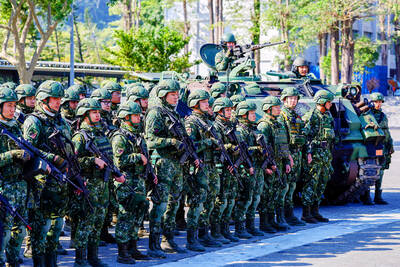China’s accelerated military development and recent activity by its military aircraft and ships around Taiwan pose an increased threat, according to a government defense report draft reviewed by Reuters.
This year’s Quadrennial Defense Review also highlights the uncertainty over the future strategic direction of the US in the region, the impact of Japan flexing its military capabilities and “conflict crisis” potential in the disputed South China Sea.
“The recent activity of Chinese jets and ships around Taiwan shows the continued rise in [China’s] military threat capabilities,” highlighting the importance of Taiwan’s need to defend itself, the draft says. “In addition to posing a military threat to our nation, it also has a negative impact on regional stability.”
The review is due to be presented to the legislature today by Minister of National Defense Feng Shih-kuan (馮世寬).
The Ministry of National Defense had no comment on the report yesterday.
The four-yearly review is the first since President Tsai Ing-wen (蔡英文) took office in May last year.
“The nation’s military development and Taiwan’s freedom and prosperity are the same living body,” the draft says.
The review comes as China has been stepping up air and sea military exercises in waters surrounding Taiwan as part of a sweeping modernization of its armed forces.
Speaking in Beijing at his annual news conference yesterday, Chinese Premier Li Keqiang (李克強) repeated that China was resolutely opposed to Taiwanese independence, but added that Beijing would uphold peace across the Taiwan Strait.
“No matter how the situation on the island may evolve, the fraternal bond between the two sides cannot be severed and will not be able to change history or the fact that both sides belong to ‘one’ and the same ‘China,’” Li said.
Developments in the South China Sea, including rejection of an international court ruling by other claimants on territorial rights of the Philippines in the disputed waters; China’s land reclamation and militarization and freedom of navigation patrols championed by the US, could deepen strife in the area, the draft says.
“Sovereignty disputes in the region and strategic competition could intensify, leading to hidden conflict crisis,” it says.
China has begun new construction work on a disputed island in the South China Sea, satellite images showed, just days ahead of the first official visit to the region by US Secretary of State Rex Tillerson.
The review also listed Japan’s move away from its pacifist constitution “to strengthen its armaments and lift a ban on using troops abroad” as having deep and far-reaching impacts on the security situation in the Asia-Pacific and the Taiwan Strait.
Reuters this week reported that Japan plans to send its largest warship on a three-month tour through the South China Sea beginning in May — its biggest show of naval force in the region since World War II.
Among security challenges for Taiwan, the review also said: “The US’ Asia-Pacific strategic direction and troop deployment was not clear” under US President Donald Trump’s administration.
Trump provoked consternation in Beijing by taking a congratulatory telephone call from Tsai and then calling into question the US’ adherence to the “one China” policy.
Last month, Trump agreed to honor the policy during a telephone call with Chinese President Xi Jinping (習近平).
The US remains Taiwan’s biggest ally and arms supplier and is bound by legislation to provide the means to help the nation defend itself.
The review reflected the realities of Taiwan’s situation, but was not specific enough on how Tsai’s government would address budget needs for major indigenous defense programs or the shrinking number of soldiers in the armed forces, said Chieh Chung (揭仲), a research fellow at the National Policy Foundation, a Chinese Nationalist Party (KMT) think tank.
The review affirmed Taiwan’s push to develop and build its own submarines, jets and ships, and strengthen its electronic and cyberdefenses against China.
Additional reporting by Ben BLANCHARD

The Central Weather Administration (CWA) today issued a sea warning for Typhoon Fung-wong effective from 5:30pm, while local governments canceled school and work for tomorrow. A land warning is expected to be issued tomorrow morning before it is expected to make landfall on Wednesday, the agency said. Taoyuan, and well as Yilan, Hualien and Penghu counties canceled work and school for tomorrow, as well as mountainous district of Taipei and New Taipei City. For updated information on closures, please visit the Directorate-General of Personnel Administration Web site. As of 5pm today, Fung-wong was about 490km south-southwest of Oluanpi (鵝鑾鼻), Taiwan's southernmost point.

Tropical Storm Fung-Wong would likely strengthen into a typhoon later today as it continues moving westward across the Pacific before heading in Taiwan’s direction next week, the Central Weather Administration (CWA) said. As of 8am, Fung-Wong was about 2,190km east-southeast of Cape Oluanpi (鵝鑾鼻), Taiwan’s southernmost point, moving westward at 25kph and possibly accelerating to 31kph, CWA data showed. The tropical storm is currently over waters east of the Philippines and still far from Taiwan, CWA forecaster Tseng Chao-cheng (曾昭誠) said, adding that it could likely strengthen into a typhoon later in the day. It is forecast to reach the South China Sea

Almost a quarter of volunteer soldiers who signed up from 2021 to last year have sought early discharge, the Legislative Yuan’s Budget Center said in a report. The report said that 12,884 of 52,674 people who volunteered in the period had sought an early exit from the military, returning NT$895.96 million (US$28.86 million) to the government. In 2021, there was a 105.34 percent rise in the volunteer recruitment rate, but the number has steadily declined since then, missing recruitment targets, the Chinese-language United Daily News said, citing the report. In 2021, only 521 volunteers dropped out of the military, the report said, citing

Nearly 5 million people have signed up to receive the government’s NT$10,000 (US$322) universal cash handout since registration opened on Wednesday last week, with deposits expected to begin tomorrow, the Ministry of Finance said yesterday. After a staggered sign-up last week — based on the final digit of the applicant’s national ID or Alien Resident Certificate number — online registration is open to all eligible Taiwanese nationals, foreign permanent residents and spouses of Taiwanese nationals. Banks are expected to start issuing deposits from 6pm today, the ministry said. Those who completed registration by yesterday are expected to receive their NT$10,000 tomorrow, National Treasury